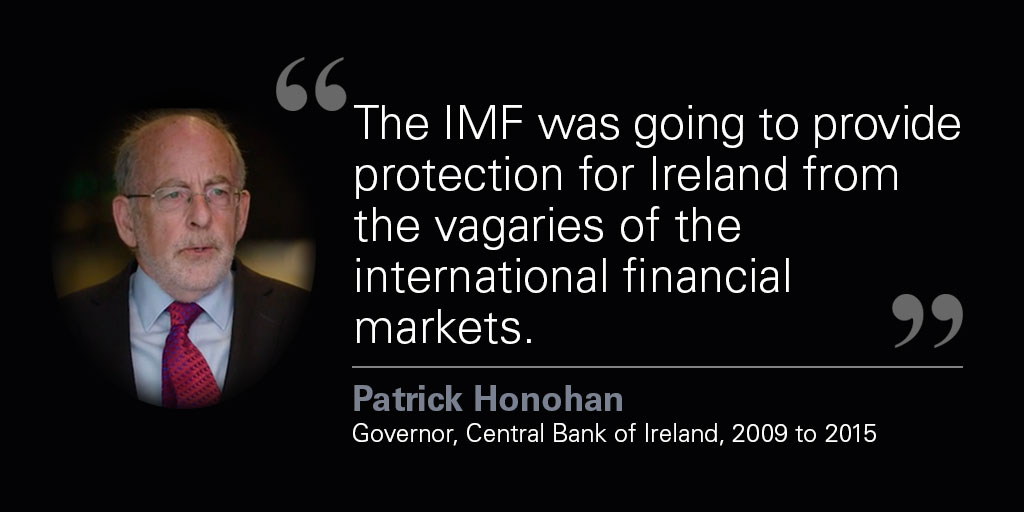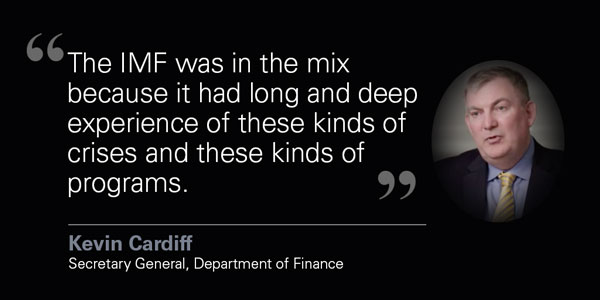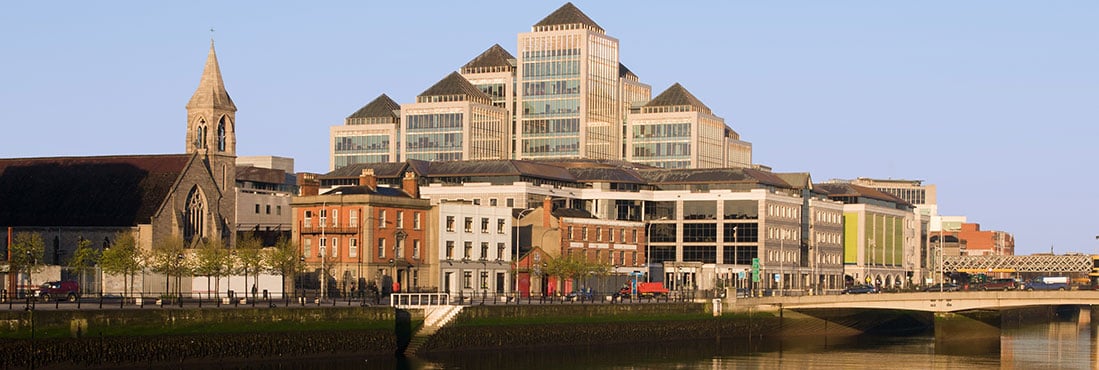Ireland: From Tiger to Phoenix
August 2018
Ireland’s housing market was booming, and Sean Hanaphy was riding high. He had left college in 2005 to join his father’s bricklaying business and was pulling down 80,000 euro a year. He bought an investment property with a friend, counting on a quick profit. Suddenly, in September 2008, the bottom fell out.
“The construction industry crumbled here completely,” Hanaphy, now 35, recalls. There was hardly any work to be found, and he couldn’t keep up with his mortgage payments. As Ireland’s economy imploded, Hanaphy’s friends started emigrating to Australia to find work. He joined the exodus.
Unemployment soared as the deepest downturn since the Great Depression gripped the country; altogether, 300,000 people, or one in every seven workers, lost their jobs by the end of 2010. But, after a difficult period of adjustment, the Irish economy started growing again. The unemployment rate fell to less than 7 percent by 2017 from a peak of more than 15 percent in 2011. It wasn’t long before Hanaphy was back in Ireland, and back in business.

The country’s remarkable recovery is a story of cooperation between the Irish government, the International Monetary Fund and the European Union. Ireland was swept up in the global financial crisis, but its problems were homegrown, and its return to economic health required homegrown solutions: restructuring banks, putting government finances back on an even keel, and working out a mountain of bad debts. The IMF and the EU provided loans and advice, but the Irish government was in the driver’s seat.
“The way I put it at the time, when speaking to the public, was that the IMF was going to provide protection for Ireland from the vagaries of the international financial markets,” said Patrick Honohan, who served as governor of Ireland’s central bank from 2009 to 2015. “Ireland needed to borrow a lot of money to keep its services going.”
Export platform
How did Ireland, once dubbed the “Celtic Tiger’’ for its fast-growing economy, end up in such trouble? In the two decades ending in 2007, the country went from being one of the poorest in the EU to one of the most prosperous. At first, low corporate taxes, moderate wages, and a young, well-educated workforce attracted corporations such as Dell, IBM, and Coca-Cola, which saw Ireland as a platform for exports of manufactured goods to the rest of Europe. Over time, the business-friendly environment also attracted pharmaceutical companies, fund managers, and Internet service firms like Google and Facebook.
Economic growth averaged more than 6 percent a year, generating hundreds of thousands of jobs. A country that had lost a quarter of its population to emigration in the 19th century became a magnet for immigrants.
But the extended boom times gave rise to private exuberance matched by complacency among banks and regulators, making fertile ground for risky speculation. Rising incomes and cheap credit — thanks in part to Ireland’s adoption of the common European currency, the euro—fueled a real estate bubble. In the decade ending in 2006, property values more than quadrupled, swelling government revenue and generating income for everyone from bricklayers to bankers.
By 2006, construction accounted for more than 12 percent of employment, the highest proportion among advanced economies. Ireland’s banks, including entrants from the UK and other EU countries, lowered their lending standards as they competed for market share. Large sums were rapidly paid out to wealthy individuals acquiring properties in Ireland and around the world. Many small businesses branched out into real estate ventures like shopping malls. Home buyers took on ever higher debts relative to their incomes, and buy-to-let investors often bought multiple properties. This vast lending on commercial and residential property expanded bank assets to five times Ireland’s GDP, mostly funded on wholesale markets rather than domestic deposits.
‘Ghost estates’
The boom ran out of steam in 2007 just as the fragilities in the global economy began to emerge. Demand for new homes and other property cooled; prices stopped rising and then started to fall. Before long, construction was at dead halt, throwing tens of thousands of people out of work. The Irish countryside was littered with partly finished housing projects known as “ghost estates,” and unfinished buildings lined Dublin’s River Liffey. Immigrant plumbers and electricians started to leave the country again in search of greener pastures, followed by Irish citizens like Hanaphy.
“When the bubble burst, the building industry collapsed, and a significant portion of the economy collapsed with it,’’ said Ann Nolan, who was just starting her job as No. 2 official in Ireland’s Department of Finance. Like many others, she was blindsided by the crisis. “We thought that within the euro, that liquidity would be there forever.”
But liquidity—in the form of money borrowed from overseas investors—began to dry up, especially after the collapse of Lehman Brothers in the United States signaled the beginning of what was to become a global crisis. With bank losses on property loans mounting and the economy slowing, nervous foreign creditors headed for the exits. The Irish government saw its budget deficit soar as tax revenue plummeted 20 percent in just two years and spending on social services rose.
“It was a perfect combination of a fiscal crisis, which was quite deep, combined with the domestic and global financial crises,” said Derek Moran, secretary general of Ireland’s Department of Finance since 2014.
On September 30, 2008, a panicked Irish government guaranteed the liabilities of the country’s six major banks. In the two years that followed, the government pumped 46 billion euros, equivalent to 30 percent of GDP, into the banks and nationalized two of them, including Anglo-Irish Bank, which had been engulfed by an accounting scandal.
The bank guarantee only delayed the day of reckoning by two years. By that time, Europe was in the grip of a full-blown crisis that would also result in bailouts for Greece, Portugal, and Cyprus. In the last four months of 2010, 60 billion euros, equal to over one-third of GDP, flowed out of Ireland. The country’s banks were being kept alive with emergency loans from the European Central Bank.
It was a situation that couldn’t last. As bank bailouts swelled Ireland’s national debt, and the declining economy weakened revenues, investors lost confidence in the government’s creditworthiness.
“The markets realized the banking failures were going to cost the government enormous amounts of money,” Honohan said. “It was clear that something had to be done, or else Irish economy as a whole would get into a kind of doom loop of higher financing costs and loss of access to the market.”
The ‘Troika’ steps in
In November 2010, the Irish government sought help from the European Union and the IMF. Together they provided loans totaling 67.5 billion euros—equal to 40 percent of Ireland’s economy—to be paid out over the next three years. A so-called “troika” of technical experts from the IMF, the European Central Bank, and the European Commission would help Ireland put its house in order.
The Fund mobilized a multinational team headed by Ashoka Mody, an economist specializing in finance (he was succeeded in early 2011 by Craig Beaumont). The team parked itself in the Merrion Hotel in central Dublin, across the street from Government Buildings, the massive Edwardian edifice that houses the Department of Finance and prime minister’s offices. Together with the staff from the European Commission and ECB, IMF team members shuttled back and forth for meetings with Irish officials, often working into the early hours of the morning.
The first order of business: stabilize the banking system to restore the confidence needed for the economy to recover, and, in time, resume the flow of credit to companies and households that is the lifeblood of any economy. This is where IMF expertise in previous crises in Latin America and Asia could be brought to bear.
Fixing the banks
“The IMF was in the mix because it had long and deep experience of these kinds of crises and these kinds of programs,” said Kevin Cardiff, the secretary general of Ireland’s Department of Finance at the time. “We wanted to take advantage of their experience and their technical knowledge.”

The Fund recommended an independent assessment to determine the value of the banks’ bad loans, and the Irish authorities hired BlackRock Solutions, a unit of the world’s largest fund manager. “The point was to identify the size of the hole in the banking system, so that measures could be taken to fill that hole and then move on,” said Ajai Chopra, who supervised the program as deputy director of the IMF’s European Department.
It would take another 24 billion euros to fill the hole. Banks were merged and their staffing reduced; over time they sold assets to be more in line with their deposits. The two nationalized banks were wound down and then liquidated, and a National Asset Management Agency was tasked to recover large commercial property loans; some 30.2 billion euro of the senior debt was issued to banks for those loans, which the agency redeemed by the end of 2017, three years ahead of schedule. The two major banks that emerged from the ruins, Bank of Ireland and Allied Irish Bank, returned to profitability in 2013 and 2014.
There were numerous complex issues, like dealing with more than 100,000 borrowers who had gone into arrears on their mortgages. Ireland had little experience modifying loans or collecting debts, because in the past, “everyone just paid,” Beaumont said. The Fund brought in experts from Norway and the United States, including a bankruptcy judge from Las Vegas, to offer advice. A new bankruptcy law was needed to make the process less punitive and to promote out-of-court agreements, while the banks needed to upgrade their resources and skills in the area. It took time, but arrears stopped rising by mid-2013, loan restructurings took off in 2013-15, and the number with arrears is down by almost half.
Painful adjustment
The second big task was to put the country’s public finances in order. Already, for three years before the EU-IMF program, the Irish government had been taking difficult measures, including a 14 percent cut in public-sector wages in 2009. These savings added up to 6.2 percent of GDP from 2008 to 2010, but the remained much too high.
Ahead of the discussions with the troika, the government set out a detailed plan to reduce the budget deficit from 2011 to 2014. The challenge would be to do that while maintaining essential services and shielding the poor.
Irish leaders “knew what the political constraints were, so they could choose the appropriate measures,” Chopra said. “Our role ended up being to tell them what the implications of certain measures might be, how it might affect distribution, how it might affect equality, and things like that, but the choice had to be theirs.”
Fiscal measures included increases in the value-added tax and carbon and motor vehicle taxes, the introduction of the Universal Social Charge (a supplementary personal income tax), reductions in the number of public servants, and savings in capital spending. Together, these steps amounted to 8 percent of GDP, two-thirds on the spending side. Gaining public support for such painful measures was critical. The government succeeded in preserving most welfare spending, which provided an important cushion against the worst effects of the crisis. Members of the IMF team held frequent press conferences and met with union leaders, opposition politicians and non-governmental organizations.
“They captured the confidence of the nation to a surprising extent,” Honohan said. “They spoke plainly, sensitively and directly. And people said, ‘Ah, these guys are actually here to help us.’”
By the end of 2012, the second year of the program, the Irish economy began to turn around, though it wasn’t obvious at the time. Firms started hiring and investing and unemployment slowly began to decline. The government tiptoed back into the financial markets, selling some short-term notes in mid-2012 as interest rates subsided, moving to bond issues later that year. Home prices in Dublin started to recover.
Hanaphy, the builder, moved back home from Australia in early 2015. Two years later, he was employing 14 people on a 700,000-euro construction contract, his biggest ever. His mortgage was paid, and he planned to marry his sweetheart when he had enough money saved.



